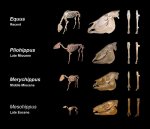Three weeks before the actual eruption, rumbling noises that resembled thunder were heard by people near Parícutin village. These were actually deep earthquakes.[SUP][3][/SUP] The volcano began as a fissure in a cornfield owned by a P'urhépecha farmer, Dionisio Pulido, on February 20, 1943. He and his wife witnessed the initial eruption of ash and stones first-hand while working in the field.[SUP][3][/SUP] The volcano grew quickly, reaching five stories tall in just a week, and it could be seen from afar in a month. Much of the volcano's growth occurred during its first year, while it was still in the explosive pyroclastic phase. The nearby villages Parícutin (after which the volcano was named) and San Juan Parangaricutiro were buried in lava and ash; the residents relocated to vacant land nearby.
At the end of this phase, after roughly one year, the volcano had grown 336 metres (1,102 feet) tall. For the next eight years the volcano continued erupting, although this was dominated by relatively quiet eruptions of lava that scorched the surrounding 25 square kilometres (9.7 square miles; 6,200 acres) of land.[SUP][4][/SUP] The volcano's activity slowly declined during this period until the last six months of the eruption, during which violent and explosive activity was frequent. In 1952, the eruption ended and Parícutin went quiet, attaining a final height of 424 metres (1,391 feet) above the cornfield where it began. The volcano has been quiet since then. Like most cinder cones, Parícutin is believed to be a monogenetic volcano, which means that once it has finished erupting, it will never erupt again. Any new eruptions in a monogenetic volcanic field will erupt in a new location.
Volcanism is a common part of the Mexican landscape. Parícutin is merely the youngest of more than 1,400 volcanic vents that exist in the Trans-Mexican Volcanic Belt and North America. Three people died as a result of lightning strikes caused by the eruptions, but no deaths were attributed to the lava nor asphyxiation.
Wikipedia
This is just a bonus. Your post just made me think of it...and I find it interesting.
At the end of this phase, after roughly one year, the volcano had grown 336 metres (1,102 feet) tall. For the next eight years the volcano continued erupting, although this was dominated by relatively quiet eruptions of lava that scorched the surrounding 25 square kilometres (9.7 square miles; 6,200 acres) of land.[SUP][4][/SUP] The volcano's activity slowly declined during this period until the last six months of the eruption, during which violent and explosive activity was frequent. In 1952, the eruption ended and Parícutin went quiet, attaining a final height of 424 metres (1,391 feet) above the cornfield where it began. The volcano has been quiet since then. Like most cinder cones, Parícutin is believed to be a monogenetic volcano, which means that once it has finished erupting, it will never erupt again. Any new eruptions in a monogenetic volcanic field will erupt in a new location.
Volcanism is a common part of the Mexican landscape. Parícutin is merely the youngest of more than 1,400 volcanic vents that exist in the Trans-Mexican Volcanic Belt and North America. Three people died as a result of lightning strikes caused by the eruptions, but no deaths were attributed to the lava nor asphyxiation.
Wikipedia
This is just a bonus. Your post just made me think of it...and I find it interesting.




